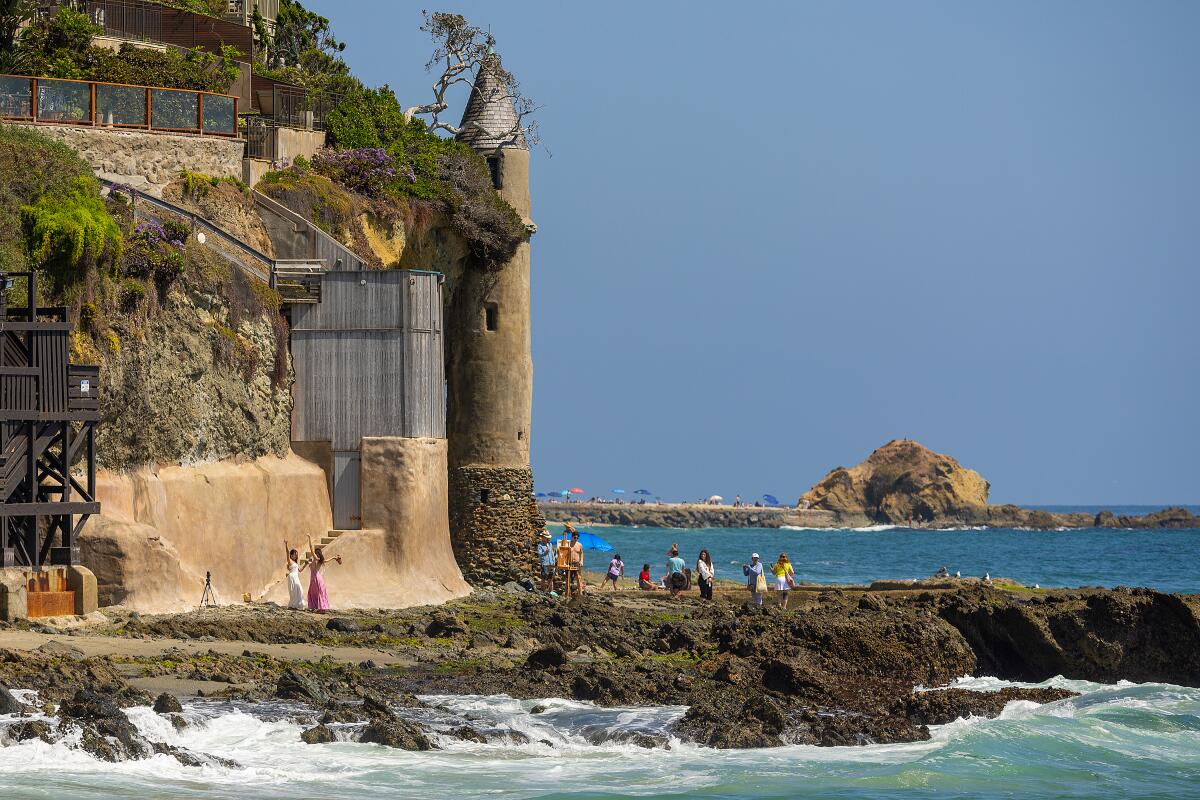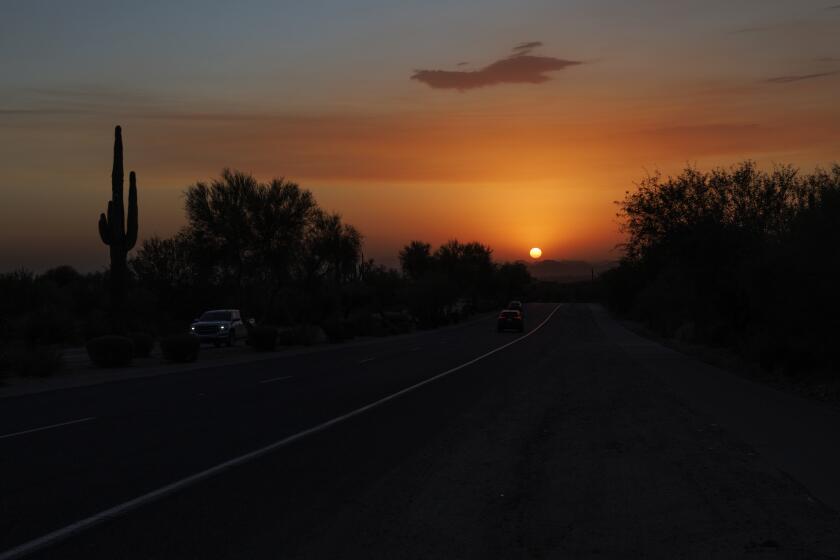Can I break three decades of anxiety and finally wear shorts at the beach?

Good morning, and welcome to the Essential California newsletter. It’s Saturday, Aug. 10. Here’s what you need to know to start your weekend:
You're reading the Essential California newsletter
Our reporters guide you through the most important news, features and recommendations of the day.
You may occasionally receive promotional content from the Los Angeles Times.
- Handling body image issues at the beach.
- Newsom threatens to take money from counties that don’t reduce homelessness.
- The 50 best beaches in Southern California.
- And here’s today’s e-newspaper
Fighting for my place on the beach
It was one of those balmy summer afternoons in Redondo Beach. The temperature hovered around 75 degrees, but the sun burned feverishly in the cloudless blue sky, making it feel hotter.
I was approaching the bluffs of the Palos Verdes Peninsula at the end of the Santa Monica Bay bike path, my electric bike humming at 10 mph. The looks and smells of California summer were all around me — volleyball games, tone bodies, bikinis, spandex biking outfits, swim trunks, shorts and tank tops, salt air and sunscreen.
I knew I looked out of place in my uniform of dark blue long-sleeved shirt and oversized black sweatpants.
Everyone was showing at least a little bit of skin — except me.
A century ago, this very stretch of the Pacific was the site of what newspapers at the time called “the battle of the beach.” It all started when a “charming blonde” arrived wearing a stunning red swimsuit, causing quite the distraction. Redondo Beach police ended up arresting her for indecent exposure, beginning a years-long debate about bodies, beachwear, decency and dress codes. The Times reported later that it took a summit of many L.A. beach towns to come up with uniform rules: “1. Men may wear trunks without uppers. 2. Women, God bless them, may not!”

The history of the L.A. coast, the history of bodies
In the height of beach season 2024, it’s easy to take the Southern California culture of surfers, hard bodies and “beach beauties” for granted. But our wide sandy beaches, frequently clean waters and guaranteed public access was the product of a century of fights, activism, greed, environmentalism and common sense. British historian Elsa Devienne chronicles how it happened in “Sand Rush,” a masterful history of the Santa Monica Bay that was published earlier this year. Devienne pulls no punches in describing the cycles of racism, homophobia, snobbery and corruption that marked the bay’s 20th century, as well as the struggles to secure public access and clean up its polluted waters.
But “Sand Rush” also tells the story about how Southern California’s beaches helped define — for better and worse — the American body.
This began more than a century ago, as our beaches set themselves apart from those on Coney Island and other coastal destinations with their, well… shallowness? “Unlike its predecessors, the Southern California beach culture was resolutely hedonistic. Gone was the preoccupation with medical and hygienist concerns: what mattered most on the beaches of Los Angeles was how good someone looked in a bathing suit and how much fun could be had,” Devienne wrote.
Beach bums and beach beauties
The more modern history of the SoCal beach body is more complex and fascinating. Muscle Beach helped popularize bodybuilding. And in the post-World War II youth boom, Hollywood brought its lenses back to the beach, this time to celebrate surfing culture. For conservative cultural commentators of the time, surfing was just one more mindless activity that allowed teens to stray and become “beach bums.” But Devienne said the athletic bodies on display on the beach were a powerful retort. Consider her description of the 1964 movie “Bikini Beach”:
The gang of teenage surfers finds an advocate in Miss Clemens, a teacher at the local high school. When the gang faces off with Harvey Huntington Honeywagon, a curmudgeonlike character inspired by railroad baron Henry Huntington who accuses surfers of being juvenile delinquents, Miss Clemens defends them by pointing to their healthy physiques: “Those surfers are building strong, healthy bodies. What’s wrong with physical fitness? You should try it sometimes.”
I cut a profile closer to Harvey Huntington Honeywagon than “Baywatch.” I weigh about 340 pounds, and my relationship with the beach has always been fraught. I grew up here and was a Santa Monica regular through high school. But I retreated in adulthood as I grew bigger and bigger. When Instagram came along, I mastered the art of taking beach sunset photos from my car that made it look like I was on the sand when I was really on the street.
My return came during the pandemic, when I brought an electric bike and cruised down the bike path for the first time since the late 1980s. The thrill of finally claiming my beach space is impossible to overstate, especially the way my bike battery made it seem to the unknowing eye that I was defying physics by peddling that fast.
Putting shame aside at the beach
My decades-long exile from the sand now feels like an unforced error. The beach is filled with bodies of different shapes and sizes. There was no reason I needed to be ashamed or afraid.
And yet as I cruised Redondo Beach recently, I wondered why I always dressed this way. I’d not worn shorts in public since the early 1990s, even on those hot days at the beach. I always told myself it was no big deal. Whatever made me comfortable was fine. But “Sand Rush” had me thinking about this differently — and about the beach‘s wonderful power to get you out of your comfort zone. Much has been written about beach season exacerbating body-image anxiety, but also about the importance of fighting through it. There is even a growing movement of “Fat Beach days” to make the sand feel accessible to all.
So when the mercury hits 80 on the bay this summer, I’m committed to leaving the sweats at home and cycling in cargo shorts. A basic choice for most beachgoers. But I see it as a major declaration of my own personal coastal access.
Because one thing “Sand Rush” makes clear, everyone needs to fight for their place at the beach.
The week’s biggest stories

California politics
- Newsom threatens to take money from counties that don’t reduce homelessness.
- California bill would require state review of private equity deals in healthcare.
- California lawmaker switches party to join GOP and criticizes Democratic leadership.
- Santa Clarita Congressman Mike Garcia says his job is to keep U.S. from becoming California.
Natural disasters
- California’s earthquake revolution: Early-warning systems make strides, issuing more than 5 million alerts.
- The landslide in Rancho Palos Verdes is getting worse. This man is fighting back.
Election 2024
- At O.C. event, JD Vance said divorces after unhappy and ‘even violent’ marriages ‘didn’t work out for the kids.’
- Willie Brown says Trump claims of helicopter trip and Kamala Harris confessions are false.
- Body-camera footage shows local police anger at Secret Service after Trump assassination attempt.
Crime & courts
- State prosecutors drop three felony counts against Los Angeles County D.A. advisor.
- City Council boosts copper wire theft crackdown with $200,000. Critics call it a waste.
- Lawsuit claims LAPD commander tried to ‘discredit’ police union. Is it part of a broader rift?
Back to school
- Summer break is ending. Here are 10 ways parents can help their kids get back into school mode.
- Parent burnout is real. Here’s what you can do about it.
- With family budgets already squeezed, back-to-school costs sting more.
L.A. art
- Isaac Psalm Escoto finds the intersection between L.A.’s art galleries and graffiti.
- The art of Xin Liu, a new ‘Company,’ musical laughs with Tim Minchin and the best art and culture in L.A. this week.
- 50 years after their historic LACMA show, Los Four are as relevant as ever.
More big stories
- Military rejects demand to mitigate effects of sonic booms and rocket launches off California coast.
- Magic mushroom chocolates are having a moment. But do they even contain mushrooms?
- L.A. contractors razed a native plant garden for kids. What happens now?
- Feds charge San Francisco towing company operator amid FBI raids.
- O, say can you see: American flag flies again, legally, at California retailer.
Get unlimited access to the Los Angeles Times. Subscribe here.
Column One
Column One is The Times’ home for narrative and longform journalism. Here’s a great piece from this week:
How two strangers found each other and solved the mystery of an L.A. watchmaker. Charles Allison liked to keep secrets about the watches he made. Perhaps that is what has made him so compelling to his grandson.
More great reads
- Once shunned, now a legend, Dusty Baker makes a triumphant Dodger return.
- Breakers are getting an Olympic stage, but will the sport eclipse the artform?
How can we make this newsletter more useful? Send comments to [email protected].
For your weekend

Going out
- 🏖️ The 50 best beaches in Southern California.
- 👀 A guide to Compton: The best things to do, see and eat.
- 🌮 18 of the best seafood tacos in L.A. from the 101 tacos guide.
Staying in
- 📺 ‘Batman: Caped Crusader’ takes the vigilante detective back to his pulpy roots.
- 🧑🍳 Here’s a recipe for cold artichoke tea sandwiches.
- ✏️ Get our free daily crossword puzzle, sudoku, word search and arcade games.
How well did you follow the news this week? Take our quiz.
On Tuesday, whom did Vice President Kamala Harris announce as her running mate? Plus nine other questions from our weekly news quiz.
Have a great weekend, from the Essential California team
Check our top stories, topics and the latest articles on latimes.com.
Sign up for Essential California
The most important California stories and recommendations in your inbox every morning.
You may occasionally receive promotional content from the Los Angeles Times.






